A single letter can be registered as a trademark, provided that it is distinctive in relation to the goods and services to which it applies. But enforcing short signs, such as single letter trademarks, is another challenge, as Fabienne Maucarré explains.
In its ruling of 9 November 2022 (Case T-610/21), the EU General Court has provided instructive insight into the enforceability of a trademark comprising a single letter.
Background to the letter trademark dispute
Let us briefly recall the facts of this case. On 10 January 2018, Mr Heinze filed a European trademark (EUTM) at the European Intellectual Property Office (EUIPO) for the sign K (pictured right) to cover, inter alia, goods in class 3, such as shampoos.

On the basis of this registration, its owner opposed the registration of the K WATER EUTM (pictured left), which was filed on 10 July 2019 by the company L'Oréal to designate various hair preparations in class 3.

The EUIPO's Opposition Division rejected the opposition on the grounds that there was no likelihood of confusion between the signs. However, this was cancelled (on appeal) by the Board of Appeal on the basis that the signs were visually and phonetically similar. Subsequently, L'Oréal appealed to the EU General Court to have the Board's decision cancelled and its mark registered.
Decision by the EU General Court in K letter trademark dispute
In its 9 November 2022 judgement, the EU General Court cancelled the decision of the Board of Appeal, thus agreeing with the position of the Opposition Division.
More specifically, the General Court held that, although the lower-order word elements K WATER were secondary to the dominant element of the letter K in the contested trademark application: "their importance cannot be reduced to the point of actually rendering them negligible and of examining the similarity of the signs solely on the basis of their dominant elements." The General Court further stated that the combination K WATER is not devoid of distinctive character and this must, therefore, be taken into account.
According to the Court, from a visual point of view, the signs differ in the design of the common letter K and the colours of the word elements of the second mark. There are additional phonetic (presence of K WATER within the contested sign) and conceptual (WATER referring to water) differences between the signs.
Although it is a short trademark, it is interesting to note that the General Court considers that the earlier mark has normal and not weak inherent distinctiveness due to the lack of significance of the letter K for the designated goods and its particular stylisation.
In order to rule out any likelihood of confusion between the signs, the General Court recalls that "the principle of interdependence should not be applied mechanically". In other words, the identity of the goods in question and the low degree of similarity between the signs are not necessarily sufficient to create a likelihood of confusion.
The General Court concluded that to recognise a likelihood of confusion between the signs in this case would be tantamount to granting a monopoly on the letter K for goods in class 3.
K letter trademark decision: implications for rights holders
While some may rightly consider this decision to be more severe than previous decisions on this topic; others may appreciate the need to limit the enforceability of short marks. Indeed, if that enforceability is not limited, the owner of a single letter trademark would enjoy a monopoly in a given sector, even though the alphabet only has 26 letters... The common and dominant presence of a letter is not enough, therefore, to create a likelihood of confusion between two signs: it is necessary to considerer their differences, even if they are secondary.
Following this ruling, whose reasoning does not seem to us to be far-fetched, it will be interesting to follow the position of the European authorities should there be any challenges to trademarks with reputation consisting of a single letter.
In the meantime and more generously, the General Court ruled on 1 March 2023 (T-25/22) that there was a likelihood of confusion between the ME and HE&ME trademarks for clothing in class 25, even though it was considered that the ME sign, consisting of two letters, had a weak distinctive character.
Does the addition of a second letter really change the situation for the a priori restricted defence of short signs – or is it not, ultimately, a matter of a more or less severe case-by-case assessment by the courts?
The content of this article is intended to provide a general guide to the subject matter. Specialist advice should be sought about your specific circumstances.


